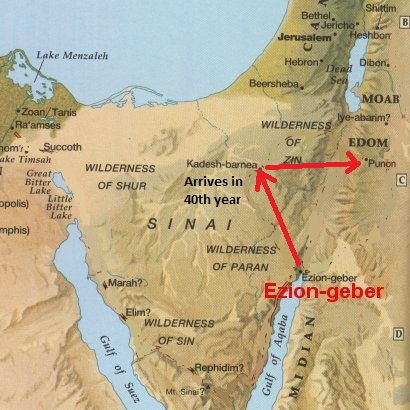As noted in previous contradictions (see #260-261, #332-334), the Torah preserves variant and contradictory traditions concerning the Israelites’ arrival at Kadedsh, when, from where, for how long, and not least of all how many times. This entry should be seen as part of these variant Kadesh traditions.
As noted in contradictions #332-334, Ezion-Geber is the last stop on the itinerary of Numbers 33 before the Israelites arrive at Kadesh, and according to this tradition for the first time and in the 40th year (Num 33:35-36). This outright contradicts Deuteronomy’s itinerary, which notes Ezion-Geber as one of Israel’s stops after Kadesh during the trek southward to the Red Sea (Deut 2:8).
So while the itinerary tradition of Numbers 33 portrays the Israelites moving from Ezion-Geber, that is from the Gulf of Aqaba on the Red Sea, to Kadesh and then through Edom, the itinerary tradition of Deuteronomy has the Israelites’ moving from Kadesh southward to Ezion-Geber on the Gulf of Aqaba then northward through Edom! Additionally, according to Numbers 33 the Israelites don’t arrive at Kadesh until the 40th year, and then they proceed into Edom after a brief stop at Hor. While in the Deuteronomic tradition they arrive at Kadesh in the 2nd year and depart toward the Gulf of Aqaba. Visually, these two traditions can be represented as follows.


Perhaps more shocking than the discrepancy concerning when the Israelites stopped at Ezion-Geber is the botched chronologies between these two traditions, which I have already dealt with in these earlier entries:
#279. How long is the journey from Kadesh to the Wadi Zered: months OR 38 years?
And the contradictory geographies treated in these earlier entries:
#275. Do the Israelites travel around Edom OR through Edom?
#278. Do the Israelites travel from Hor to Oboth OR to Zalmonah?
#281. Did the Israelites pass around Moab OR through Moab?
And in general see the summary given in this post: The Wilderness Itinerary from the Exodus to the Plains of Moab: An Introduction to Numbers 33
Dear Dr. DiMattei,
Thank you for your exhaustive and painstaking analyses of what many in this country consider the inerrant and inspired word of God. It would appear that after reading even only a few of your observations this position is untenable. The alternative hypothesis, namely that this is the result of numerous unscrupulous “editors” with very different theological agendas concocting over a prolonged period of time a bizarre amalgamate full of contradictions and errors, is logical and supported by the facts you identify. I am particularly fond of your insights into the machinations of the “Aaronite” faction to make the Torah fit their all too human desires for power and wealth. I hope you will have the time to extend your research to other parts of the OT and the NT as well.
In your article, you said according to Numbers’ tradition for the first time and in the 40th year (Num 33:35-36). However, back in Numbers 13:26, the Israelites were in Kadesh already. So Numbers 33:35 is at least the second time there. I think nore work needs to be done so that no detail is missed.